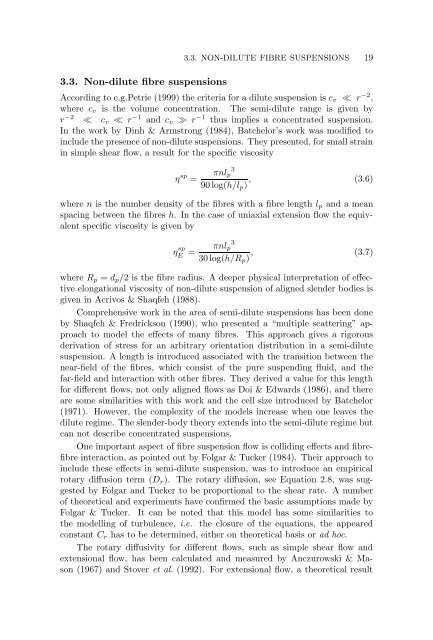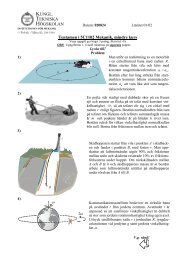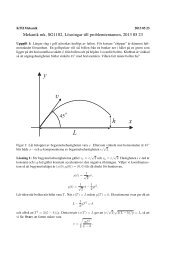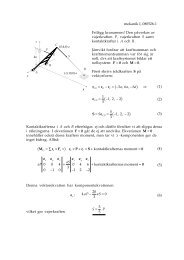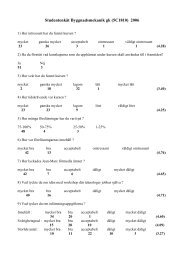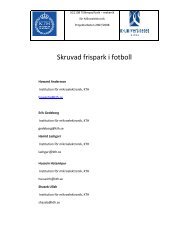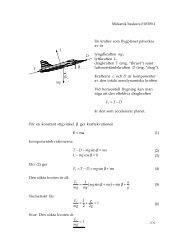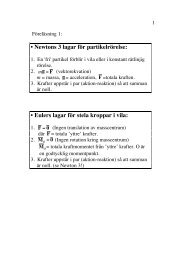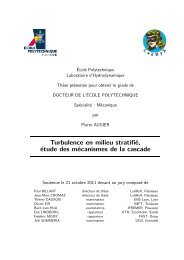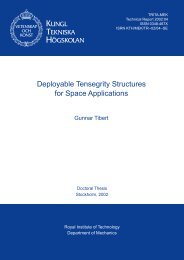Fluid mechanics of fibre suspensions related to papermaking - DiVA
Fluid mechanics of fibre suspensions related to papermaking - DiVA
Fluid mechanics of fibre suspensions related to papermaking - DiVA
Create successful ePaper yourself
Turn your PDF publications into a flip-book with our unique Google optimized e-Paper software.
3.3. Non-dilute <strong>fibre</strong> <strong>suspensions</strong><br />
3.3. NON-DILUTE FIBRE SUSPENSIONS 19<br />
According <strong>to</strong> e.g.Petrie (1999) the criteria for a dilute suspension is cv ≪ r −2 ,<br />
where cv is the volume concentration. The semi-dilute range is given by<br />
r −2 ≪ cv ≪ r −1 and cv ≫ r −1 thus implies a concentrated suspension.<br />
In the work by Dinh & Armstrong (1984), Batchelor’s work was modified <strong>to</strong><br />
include the presence <strong>of</strong> non-dilute <strong>suspensions</strong>. They presented, for small strain<br />
in simple shear flow, a result for the specific viscosity<br />
η sp =<br />
πnlp 3<br />
, (3.6)<br />
90 log(h/lp)<br />
where n is the number density <strong>of</strong> the <strong>fibre</strong>s with a <strong>fibre</strong> length lp and a mean<br />
spacing between the <strong>fibre</strong>s h. In the case <strong>of</strong> uniaxial extension flow the equivalent<br />
specific viscosity is given by<br />
η sp<br />
E =<br />
πnlp 3<br />
, (3.7)<br />
30 log(h/Rp)<br />
where Rp = dp/2 is the <strong>fibre</strong> radius. A deeper physical interpretation <strong>of</strong> effective<br />
elongational viscosity <strong>of</strong> non-dilute suspension <strong>of</strong> aligned slender bodies is<br />
given in Acrivos & Shaqfeh (1988).<br />
Comprehensive work in the area <strong>of</strong> semi-dilute <strong>suspensions</strong> has been done<br />
by Shaqfeh & Fredrickson (1990), who presented a “multiple scattering” approach<br />
<strong>to</strong> model the effects <strong>of</strong> many <strong>fibre</strong>s. This approach gives a rigorous<br />
derivation <strong>of</strong> stress for an arbitrary orientation distribution in a semi-dilute<br />
suspension. A length is introduced associated with the transition between the<br />
near-field <strong>of</strong> the <strong>fibre</strong>s, which consist <strong>of</strong> the pure suspending fluid, and the<br />
far-field and interaction with other <strong>fibre</strong>s. They derived a value for this length<br />
for different flows, not only aligned flows as Doi & Edwards (1986), and there<br />
are some similarities with this work and the cell size introduced by Batchelor<br />
(1971). However, the complexity <strong>of</strong> the models increase when one leaves the<br />
dilute regime. The slender-body theory extends in<strong>to</strong> the semi-dilute regime but<br />
can not describe concentrated <strong>suspensions</strong>.<br />
One important aspect <strong>of</strong> <strong>fibre</strong> suspension flow is colliding effects and <strong>fibre</strong><strong>fibre</strong><br />
interaction, as pointed out by Folgar & Tucker (1984). Their approach <strong>to</strong><br />
include these effects in semi-dilute suspension, was <strong>to</strong> introduce an empirical<br />
rotary diffusion term (Dr). The rotary diffusion, see Equation 2.8, was suggested<br />
by Folgar and Tucker <strong>to</strong> be proportional <strong>to</strong> the shear rate. A number<br />
<strong>of</strong> theoretical and experiments have confirmed the basic assumptions made by<br />
Folgar & Tucker. It can be noted that this model has some similarities <strong>to</strong><br />
the modelling <strong>of</strong> turbulence, i.e. the closure <strong>of</strong> the equations, the appeared<br />
constant Cr has <strong>to</strong> be determined, either on theoretical basis or ad hoc.<br />
The rotary diffusivity for different flows, such as simple shear flow and<br />
extensional flow, has been calculated and measured by Anczurowski & Mason<br />
(1967) and S<strong>to</strong>ver et al. (1992). For extensional flow, a theoretical result


